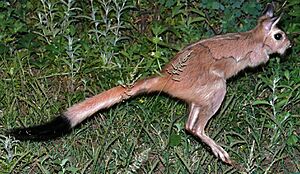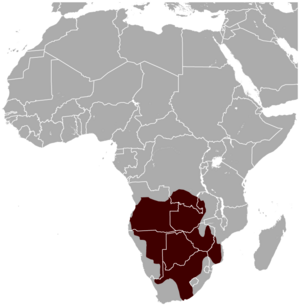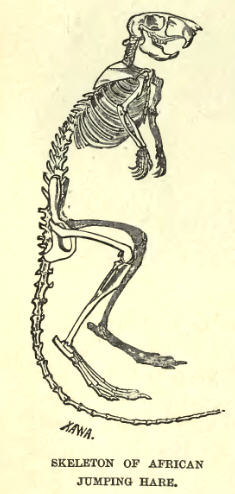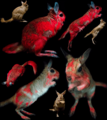South African springhare facts for kids
Quick facts for kids South African springhare |
|
|---|---|
 |
|
| Conservation status | |
| Scientific classification | |
| Genus: |
Pedetes
|
| Species: |
capensis
|
 |
|
| South African springhare range. | |
| Synonyms | |
|
|
The South African springhare (Pedetes capensis) (Afrikaans: springhaas) is a medium-sized animal. It lives on land and digs burrows. Even though it's called a "hare," it's actually a rodent, like a mouse or a rat. It's one of two types of springhares in the world. This species lives in southern Africa.
Springhares live in dry areas of southern Africa. They prefer sandy places with short grasses. Sometimes, they eat crops on farms. This can make them a pest to farmers. But don't worry, they are not in danger of disappearing.
Contents
What Makes Them Special?
The springhare looks a bit like a small kangaroo. It has strong back legs and short front legs. Its long tail is about half its body length. Springhares also have big eyes and ears. Adult springhares can grow up to 80 cm (31 in) long. They usually weigh between 2.7 kg (6.0 lb) and 3.5 kg (7.7 lb).
Like kangaroos, springhares use their tails for balance when they hop. They can hop about 20 cm (7.9 in) high. They can also leap up to 2 m (6 ft 7 in) far!
Their fur is long and soft. It's shorter around their legs, heads, and ears. Their fur is reddish-brown on top and off-white on their belly. The tip of their tail is black. Sometimes, their ear tips are black too. Young springhares have softer, fluffier fur. They often have black patches under their back feet and near the base of their tail.
Springhares have different numbers of toes on their front and back legs. Their short front legs have five toes. Each toe has a long, sharp, curved claw, up to 16 millimeters long. Their long back legs have four toes. Three of these toes are well-developed and have strong, triangle-shaped nails.
The oldest springhare ever recorded lived for 7 years and 4 months.
Glowing Fur: Biofluorescence
Springhare fur can actually glow under special light! This is called biofluorescence. Not all of their fur glows, but certain areas do. These areas are important for grooming and for talking to other springhares. Scientists are still learning about why their fur glows. Springhares are the first mammals from the "Old World" (Europe, Asia, Africa) found to have this glowing fur.
Ear Regeneration
Scientists have studied how well springhares can regrow parts of their ears. They found that springhares can regrow a little bit of ear tissue. However, they are not as good at it as rabbits.
How They Live: Ecology and Behaviour
Springhares are nocturnal animals. This means they are active at night. They look for food when it's dark. During the day, they go back to their burrows to sleep. When they sleep, they stand up. They bend their head and front legs down between their back legs. Their tail is wrapped around their feet.
Many animals hunt springhares. Humans also hunt them. In the Kalahari, at least 21 different animals hunt springhares.
Digging Burrows
Springhares are excellent diggers. They dig their own burrows in sandy soil. They prefer to dig when the ground is wet.
The front claws loosen soil from the burrow wall while the teeth cut through roots. The front feet toss the soil beneath the body and the hind feet kick it further back. When the pile of loosened soil is large enough, the springhare turns around, and with its chin, chest and front feet held up against the pile, it pushes the soil to the entrance with thrusts of the hind feet.
Burrows are often found near trees or bushes. These plants are not common where springhares live. The plants might help hide the burrows. They also give the springhares a landmark to find their way back. A springhare's burrow is about 20 cm wide. It can be up to 1 meter deep and 7 meters long. Some burrows can cover an area as big as 170 square meters.
Springhare burrows usually have several entrances. There are two types of entrances:
- One type is easy to see because there's a pile of sand at the opening.
- The other type is "hidden" with no sand pile.
Springhares stay close to one of their burrow entrances when they eat. If something scares them, they run back to their own burrow. They don't use other burrows they pass. Springhares often use burrows in areas from 0.6 to 28.5 hectares.
Springhares usually only stay in one burrow for a few days. One study found that springhares used 4 to 27 different burrows. Most burrows (70%) were used by only one springhare. It was rare for more than two springhares to share a burrow. They also rarely lived together in the same burrow at the same time.
The same burrows can be used by many generations of springhares. New tunnels can be added as needed. Springhares don't seem to fight over their burrows or territory. But they do mark their burrows. They use special glands or pee at the entrance. This probably tells other springhares that the burrow is taken.
Springhares can block their burrow entrances with soil. They make two types of plugs:
- Temporary plugs are made from inside the burrow. These might be to keep predators out.
- Permanent plugs are long (0.5 – 3 m). They can sometimes fill entire tunnels.
Empty springhare burrows are sometimes used by other animals. These include the black-footed cat and the ground pangolin.
What They Eat: Feeding and Foraging
Springhares are herbivores. This means they eat plants. They eat roots, stems, leaves, and seeds. But they are picky eaters. They often leave a lot of plant material behind. Sometimes, springhares might eat insects like beetles or locusts. They might even eat dead animals.
Springhares eat at night. They can travel 150 to 400 meters away from their burrow to find food. They sometimes eat in large groups of up to nine springhares. When they are in groups, they don't fight or act territorial.
Life Cycle and Reproduction
Springhares can have babies all year round. Pregnancy lasts about 77 days. Females usually give birth to one baby about three times a year. A female can even be nursing a baby and be pregnant at the same time!
Scientists think they can breed all year because of a few reasons:
- They choose only the best parts of plants to eat.
- They have many different types of food available, both above and below ground.
- They have special ways their bodies and behaviors help them live in dry areas.
Springhares give birth in a burrow. The baby is born with fur and weighs about 250-300 grams. Usually, it's just one baby, but twins can happen. While the baby is in the burrow, the mother stops moving to different burrows. She stays in the burrow with her baby. The baby drinks only her milk. The baby stays in the burrow for about seven weeks. By then, it weighs about 1.3 kg. This long time with their parents helps make up for the fact that they don't have many babies at once.
Traditional Uses by People
The San and baTswana people have traditionally used springhares. Both groups hunt springhares for their meat. One springhare can provide up to 1360 grams (3 lb.) of meat.
Besides meat, the San people use springhare skins for many things. They make bags, mats, and karosses (clothes or blankets made from animal skins). They also make hats. The tail provides strong fibers for sewing. People can also make a belt that makes sounds by tying springhare toes onto a string.
Gallery








